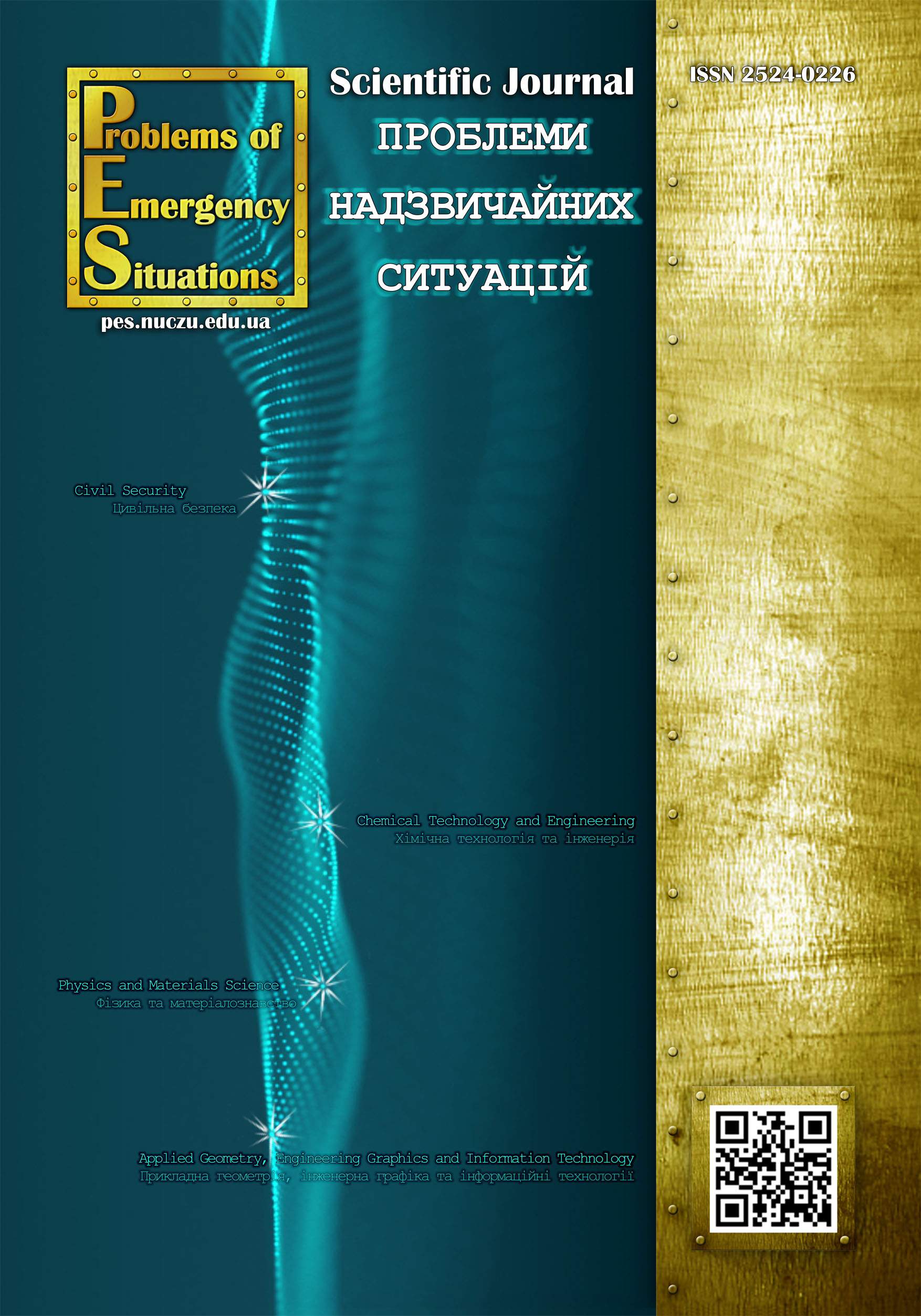Durieiev Viacheslav
National University of Civil Protection of Ukraine
https://orcid.org/0000-0002-7981-6779
Bondarenko Serhiy
National University of Civil Protection of Ukraine
http://orcid.org/0000-0002-4687-1763
Antoshkin Oleksiy
National University of Civil Protection of Ukraine
http://orcid.org/0000-0003-2481-2030
Mykhailovska Yuliia
National University of Civil Protection of Ukraine
https://orcid.org/0000-0003-1090-5033
Maliarov Murat
National University of Civil Protection of Ukraine
http://orcid.org/0000-0002-4052-7128
Murin Mikhail
National University of Civil Protection of Ukraine
https://orcid.org/0000-0002-9898-0128
DOI: https://doi.org/10.52363/2524-0226-2025-41-4
Keywords: adaptive system, time constant, executive device, pulse width modulation, duty cycle
Аnnotation
A functional model of the pulse-width modulation device was developed to convert a continuous normalized input analog signal into a proportional output signal of the pulse-width modulation executive device of the fire protection system. An analysis of the scientific literature was carried out, which made it possible to take into account in mathematical models the use of pulse-width modulation of the control signal for controlling the operation of an inertial executive device, which was not considered before. A feature of the developed functional model is the use of pulse-width modulation of the control signal to control the operation of the inertial actuator. It has been proved that for the formation of the control signal of the operation of the executive device, the model of the device of pulse width modulation of the control signal must take into account the type, parameters of operation and structural features of the executive device. The study of the impact of the pulse-width modulated control signal on the executive device was carried out. The dependence of the signal spread at the output of the executive device with a given time constant on the dimensionless parameter presented in the logarithmic coordinate system is presented. The dependence of the spread and error of the signal at the output of the executive device with a given value of the time constant on the value of the control signal, the frequency of pulse-width modulation and the inertia of the real executive device is determined. A dimensionless criterion is proposed for determining the parameters of the pulse-width modulation of the control signal of the executive device with the given inertia and spread of the control signal. The results of the application of the functional model confirm the validity of the accepted hypothesis, and the calculated operating parameters of the executive device correspond to the experimental data. Recommendations for determining the parameters of continuous control of the executive device have been formulated.
References
- Passenbrunner, T., Sassano, M., Trogmann, H., del Re L., Paulweber, M., Schmidt, M., Koka Passenbrunner, T., Sassano, M., Trogmann, H., del Re L., Paulweber, M., Schmidt, M., Kokal, H. (2011). Inverse torque control of hydrodynamic dynamometers for combustion engine test benches. Proceedings of the American Control Conference, 4598 – 4603. Available at: https://www.researchgate.net/publication/
224254112_Inverse_torque_control_of_hydrodynamic_dynamometers_for_combustion_engine_test_benches - Torabnia, S., Banazadeh, A. (2014). Development of a water brake dynamometer with regard to the modular product design methodology, Proceedings of the ASME 2014. 12th Biennial Conference on Engineering Systems Design and Analysis, 15, 20229–20232. doi:10.1115/ESDA2014-20232
- Shao,T., et al. (2019). A robust power regulation controller to enhance dynamic performance of voltage source converters, In IEEE Transactions on Power Electronics, 34, 12407–12422. Dec. 2019. doi: 10.1109/TPEL.2019.2906057
- Kustanovich, Z., Reissner, F., Shivratri, S., Weiss, G. (2021). The sensitivity of grid-connected synchronverters with respect to measurement errors. IEEE Access, 9, 118985–118995. doi:10.1109/ACCESS.2021.3107345
- Aouini, R., Marinescu, B., Ben, Kilani, K., Elleuch, M. (2016). Synchronverter-based emulation and control of HVDC transmission. IEEE Trans. PowerSystems, 31, 278–286. Available at: https://www.researchgate.net/publication/322998600_
Synchronverter-based_emulation_and_control_of_HVDC_transmission - Ashabani, M., Jung, J. (2020). Synchronous voltage controllers: Voltage-basedemulation of synchronous machines for the integration of renewable energy sources. IEEE Access, 8, 49497–49508. doi:10.1109/ACCESS.2020.2976892
- Busada, C.A., Jorge, S. G., Solsona, J. A. (2021). Output admittance synthesizerfor synchronverters. In IEEE Transactions on Industrial Electronics. doi:10.1109/TIE.2023.3277109
- Abo-Khalil, A.G., Al-Qawasmi, A.-R., Eltamaly, A. M., Yu, B. G. (2020). Condition monitoring of DC-Link Electrolytic Capacitors in PWM power converters using OBL method. Sustainability, 12, 719–726. Available at: https://www.
mdpi.com/2071-1050/12/9/3719 - Mandrile, F., Musumeci, S., Carpaneto, E., Bojoi, R., Dragicevicand, T., Blaabjerg, F. (2020). State-space modeling techniques of emerging grid-connected converters. Energies, 13. doi:10.3390/en13184824
- Zabara, S. (2015). Modelyuvannya sistem u seredovishchі MATLAB. Unіversitet Ukraїna, 137. Available at: https://www.yakaboo.ua/modeljuvannja-sistem-u-seredovischi-matlab.html
l, H. (2011). Inverse torque control of hydrodynamic dynamometers for combustion engine test benches. Proceedings of the American Control Conference, 4598 – 4603. Available at: https://www.researchgate.net/publication/
224254112_Inverse_torque_control_of_hydrodynamic_dynamometers_for_combustion_engine_test_benches
- Torabnia, S., Banazadeh, A. (2014). Development of a water brake dyna-mometer with regard to the modular product design methodology, Proceedings of the ASME 2014. 12th Biennial Conference on Engineering Systems Design and Analysis, 15, 20229–20232. doi:10.1115/ESDA2014-20232
- Shao, T., et al. (2019). A robust power regulation controller to enhance dy-namic performance of voltage source converters, In IEEE Transactions on Power Electronics, 34, 12407–12422. Dec. 2019. doi: 10.1109/TPEL.2019.2906057
- Kustanovich, Z., Reissner, F., Shivratri, S., Weiss, G. (2021). The sensitivity of grid-connected synchronverters with respect to measurement errors. IEEE Access, 9, 118985–118995. doi:10.1109/ACCESS.2021.3107345
- Aouini, R., Marinescu, B., Ben, Kilani, K., Elleuch, M. (2016). Synchron-verter-based emulation and control of HVDC transmission. IEEE Trans. PowerSys-tems, 31, 278–286. Available at: https://www.researchgate.net/publication/322998600_
Synchronverter-based_emulation_and_control_of_HVDC_transmission
- Ashabani, M., Jung, J. (2020). Synchronous voltage controllers: Voltage-basedemulation of synchronous machines for the integration of renewable energy sources. IEEE Access, 8, 49497–49508. doi:10.1109/ACCESS.2020.2976892
- Busada, C. A., Jorge, S. G., Solsona, J. A. (2021). Output admittance synthe-sizerfor synchronverters. In IEEE Transactions on Industrial Electronics. doi:10.1109/TIE.2023.3277109
- Abo-Khalil, A. G., Al-Qawasmi, A.-R., Eltamaly, A. M., Yu, B. G. (2020). Condition monitoring of DC-Link Electrolytic Capacitors in PWM power converters using OBL method. Sustainability, 12, 719–726. Available at: https://www.
mdpi.com/2071-1050/12/9/3719
- Mandrile, F., Musumeci, S., Carpaneto, E., Bojoi, R., Dragicevicand, T., Blaabjerg, F. (2020). State-space modeling techniques of emerging grid-connected converters. Energies, 13. doi:10.3390/en13184824
- Zabara, S. (2015). Modelyuvannya sistem u seredovishchі MATLAB. Unіversitet Ukraїna, 137. Available at: https://www.yakaboo.ua/modeljuvannja-sistem-u-seredovischi-matlab.html














